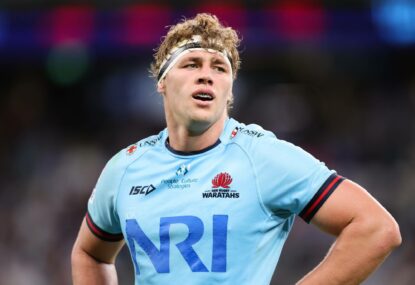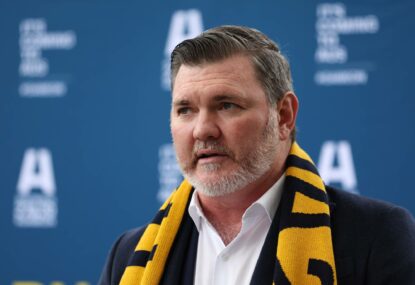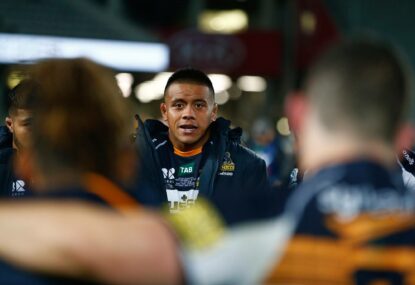The 1939/40 Wallaby tour to the northern hemisphere was conceived on a scale so grand never before seen nor considered since. The 28 match, four Test tour of England, Wales, Scotland and Ireland was only part of this grand adventure.
According to the biography of 1939/40 tourist Stan Bisset, ‘Kokoda Wallaby’ (a great read), following the tour of the British Isles and Ireland, which would last from early September through to early January, the team would then cross the English Channel to play two Tests against France and one against Germany.
Yes, Germany. Throughout the 1930s, Germany had gone to great lengths to develop their rugby as part of their Aryan race superiority and usurp France as the dominant rugby nation on continental Europe.
Arranging a Test match against the Wallabies, one of the traditional ‘big eight’ rugby nations, was indeed a coup.
Nor did the tour end there. The team would board yet another ship and steam across the Atlantic Ocean to North America, playing yet more tour games, including two Tests against the USA and one against Canada.
They were not yet done, however, as the team would then steam across the Pacific Ocean to New Zealand, stopping off for some more tour matches and two Tests against the All Blacks.
Apart from mentioning the number of extra Test matches proposed, Bisset does not indicate the total number of extra tour matches envisaged.
I’m guessing the entire tour, had it been run in its entirety, would have been around 44 tour matches, including a staggering 12 Tests! The entire tour, including sailing time, would have taken around 10 months.
The concept of playing 12 Tests in 10 months would not be seen on a regular basis until the arrival of professional rugby in 1995/96.
This is why the players chosen for this grandly-conceived, record-breaking tour were known as ‘The Lucky 29′.
In those days, the touring side was always selected with one forward short of two full teams, which is why only 29 players, not the usual 30, were considered for selection.
Locks had more utility value in those days, being able to switch either to the front-row or back-row as required. On this particular tour the selectors only chose three frontline locks. Two of the four props were recently-converted locks.
It also explains the bitter disappointment of those who missed selection. In the case of veteran centre Cyril Towers, he felt only seething contempt for the selectors at his omission.
Towers, one of Australian rugby’s most celebrated centres, had now missed two major tours when Wally Matthews was tour manager. The first occasion was in 1933 to South Africa, and now the 1939/40 tour of Europe and North America.
Matthews and Towers simply didn’t get on. Matthews considered Towers highly opinionated, headstrong and potentially disruptive. Having now read quite a few stories about Towers, I feel Matthews is probably quite correct in his summation!
While there is simply no excuse whatsoever for Towers’ omission in 1933, there were probably significant extenuating circumstances for his omission in 1939.
Towers would have turned 33 during this tour, meaning he was about five years older than the next oldest player in the team. The ‘generation gap’ might have been too great, increasing Towers’ remoteness from the other players.
The touring party contained 17 players from New South Wales, eight from Queensland and four from Victoria.
Not until the arrival of the Melbourne Rebels in 2011 would we again see such significant representation from the state south of the Murray River. This was indeed a tour before its time in more ways than one!
Vay Wilson, a lock turned prop from Queensland, was captain of the side while scrumhalf Mickey Gibbons from NSW was vice-captain.
The bulk of the team left Sydney on 21 July 1939 aboard the SS Mooltan, picking up the Victorians in Melbourne on 25 July, before skirting the Southern Ocean and crossing the Indian Ocean up through the Suez Canal and into the Mediterranean Sea.
The team stopped off in Cairo to visit the pyramids and enjoy some camel riding.
While at sea the team was incubated from the enveloping storm clouds of war sweeping across Europe. When the ship berthed at the southern French port of Marseilles, the team was alarmed to see much of the city observing ‘blackout’.
Perhaps for the first time, the players realised they might not get to complete the tour. But surely, they should be able to complete most of it?
The SS Mooltan then steamed out past Gibraltar into the Atlantic Ocean before disembarking at Southampton on Saturday 2 September. The team caught the overnight train to Torquay in Dover, where they were billeted at the Grand Hotel overlooking the sea.
The following morning, Sunday 3 September, the team gathered excitedly in the foyer lounge to discuss the coming tour.
At 11 am, a ‘shoosh’ order was relayed to the hotel crowd as the British Prime Minister Neville Chamberlain was about to make a live national broadcast on radio.
Chamberlain spoke slowly and gravely, with the resigned tone of a man who had endured too much stress as he was about to deliver to his nation a massive clanger.
“I am speaking to you from the Cabinet Room at 10 Downing Street. This morning the British Ambassador in Berlin handed the German Government a final note stating that, unless we heard from them by 11 o’clock [Berlin time – one hour ahead] that they were prepared at once to withdraw their troops from Poland, a state of war would exist between us.
“I have to tell you now no such undertaking has been received, and that consequently this country is at war with Germany.”
So there it was – War! As you can imagine, everyone was in a state of shock. By the next day it was confirmed, the tour was off. Just one day after arriving in England, war had been declared.
The team would remain in South England for a further two weeks, helping to sandbag the hotel and other buildings, visiting London, and on the day before they began their return journey to Australia, have an audience with King George VI and Queen Mary.
In part two, I will provide pen-portraits of ‘The Lucky 29’ and the fate that befell some of them during the war.


































































































